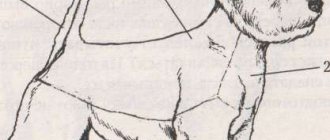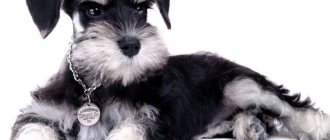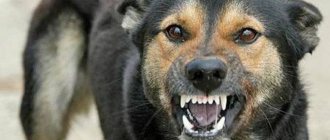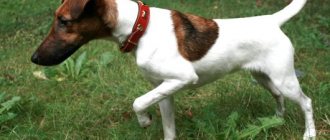Origin
The Wire Fox Terrier has an ancient and rich history. Its homeland is the British Isles. The dog was first mentioned in writing in the 12th century. Terriers are a large group of breeds, making it difficult to sort through the confusing pedigrees. The ancestors of the Fox could have been turf dogs or hounds crossed with terriers. The name of the breed comes from the Latin word terra, which means earth. It reflects the purpose of the dog - hunting burrowing animals. It is also clear from the name that terriers were used to bait foxes.
The first breeding work began in the 17th century. At the same time, the characteristic features of the breed began to form. The Fox Terrier began to take on recognizable features due to the infusion of blood from smooth-haired, white and wire-haired terriers, as well as hounds, dachshunds, spaniels and beagles. The latest breeds of dogs were allowed to be crossed in very measured doses, so as not to harm the appearance of the Fox and improve its working qualities.
In the 18th century, fox hunting gained enormous popularity, which could not but affect the demand for terriers: the dogs' task was to drive the animal out of the hole. Most often, they worked in tandem with foxhounds, which drove prey, but could not fit into narrow crevices. The smooth-haired variety of the terrier was more preferable: the short coat did not accumulate soil and dirt, and was therefore easy to clean. An important condition was the predominance of white in color - this helped hunters not to lose sight of the dog.
Hunters transported foxes in special travel bags or shoulder bags. This compensated for the lack of speed and endurance.
Performance optimization continued into the 19th century. During selection, fox terriers became much more compact: their shoulders and skulls narrowed, and the gap between the shoulder blades decreased. Foxes were first shown at an exhibition in 1859, and already in 1886 the first special breed exhibition took place. The standard was formalized in 1876.
In the eighties, terriers became popular outside of England. They were exported to Russia, Austria and Germany. One of the largest breeders was Francis Redmont. Puppies from his kennel have been distributed all over the world.
Interesting Facts
- Fox Terriers were kept by Albert Einstein, Maxim Gorky, Charles Darwin and English kings;
- In the American resort town of Coronado (Costa Rica), dog surfing competitions are held annually. The winners of these competitions are often fox terriers;
- The canine department of the Russian Ministry of Emergency Situations actively uses fox terriers to search for people who are trapped under rubble or disappeared in the mountains;
- Fox terriers often became heroes of literary works (the story “Three in a Boat, Not Counting the Dog”, the children’s book “The Diary of Fox Mickey”, the cycle of stories “Dasha, or the story of a puppy’s life”);
- There are organizations in England that train fox terriers to collect donations that go to charitable causes.
- Fox Terrier George from New Zealand sacrificed his life to save young children from angry pit bulls.
Description of the breed
The Fox Terrier is a strong, tightly built, small dog. The breed has two varieties:
- Wirehaired. The coat is coarse, moderately long, and resembles a beard on the muzzle.
- Smooth-haired. The coat is short, straight and smooth. Fits tightly to the dog's body.
Breed standard for Wire Fox Terrier:
- Dimensions: height – up to 40 cm, weight – up to 8 kg.
- The body is of rectangular proportions, lean.
- The skull is flattened, tapering towards the end of the muzzle. Smooth transition from forehead to muzzle.
- The jaws are tenacious, tightly clenched. Scissor bite.
- The eyes are round and dark. The distance between them is moderate.
- The ears are set high, triangular, with tips drooping forward.
- The neck is moderately long, with a graceful arch.
- The back is strong, short and straight.
- The chest is narrow, set deep.
- The front legs are straight and strong. The hind legs are muscular.
- The tail is absolutely straight, always looking up. Most often docked.
The wool is thick and dense, with a wire-like structure. On the limbs and back – very hard and abundant. The fur on the face is straight and long, forming a charismatic beard. Colour: There may be black and tan, black or brown spots on a predominantly white background. Violation of the standard: red, blue, brown and brindle spots.
Character
The Fox Terrier is an active and energetic dog breed. They arrive in constant motion and charge their owners with optimism and love of life. Foxes have a penchant for adventure and are easily influenced. Owners should remember that terriers are hunting dogs. They are just waiting to chase a cat or small dog, so they should not be taken for walks without a leash. Having succumbed to the euphoria of the chase, the fox terrier will not listen to the owner: neither loud screams nor orders to stop will help. If the dog catches up with the prey, it is likely to cause serious damage to it.
Foxes are often stubborn and do not want to obey their owner's commands. This creates difficulties during training. Terriers are considered unteachable. Of course, this is not true. If the dog does not respond to commands, it means that it considers them unjustified.
Despite their natural intractability, fox terriers are excellent companions. They love fun games and are always friendly. This is an ideal breed for active owners. Foxes love long walks and have an inexhaustible supply of energy. Terriers get along well with children and are ready to forgive them everything except physical violence.
It is not recommended to leave children in the company of fox terriers. Dogs can mistake careless handling for intentional aggression and will immediately take revenge.
One of the main disadvantages of Foxes is their loud, unreasonable barking. This is a frequent cause for conflicts with neighbors. In addition, dogs show dissatisfaction with their owner by biting or growling. In this case, it is better to seek help from professional sinologists rather than physically punish your pet.
How to choose a Fox Terrier puppy?
Kennels usually start selling fox terrier puppies when they are 1.5-2 months old. Pay attention to the dog's appearance. The puppy must be well-fed and have a hard coat with a thick undercoat. Watch a group of small fox terriers. Try to identify and select a “team leader” who dominates the rest of the animals. A Fox Terrier puppy should be active and a little aggressive. This behavior is a variant of the norm.
Carefully study the animal's pedigree. Bad genetics is a guarantee of the occurrence of severe chronic diseases in a dog. If your family has small children, then it is better to take a female. She is calm about the child's tricks. The male dog has a tougher and more capricious character. If you decide to adopt a dog for hunting, then you need to pay attention to the viscosity (persistence in pursuing prey) and the viciousness of its parents.
Care and maintenance
Fox Terriers are suitable for apartment living, but require regular walks and exercise. A bored dog is prone to destructive behavior. In order to save your house from a pogrom, you need to follow a daily exercise plan. In addition to walking, it is recommended to visit dog parks and play outdoor games.
If the fox spends a lot of time in the yard, you should fence off the space for him with an enclosure. Otherwise, he will start digging hole after hole, and then take up the beds and flower beds. Unfortunately, even a fence does not guarantee safety: the fox terrier will begin to dig in order to break free.
Another important aspect of maintenance is regular grooming. It needs to be brushed daily with a stiff bristle brush and trimmed several times a year. Trimming is a complex of decorative and hygienic procedures. It includes thorough combing of the undercoat and tearing/plucking of the top coat. Grooming involves uniformly shortening the coat. This leads to softening of the hair structure and provokes rapid contamination. Grooming is not encouraged at shows and is harmful to the dog's coat.
Dead fur causes severe itching: Foxes begin to itch furiously and injure the skin. To prevent eczema, you need to trim your dog 2-3 times a year. After this, even the persistent dog smell disappears.
The dog's ears are cleaned once a month. The outer part of the auricle is wiped with a cotton pad or swab dipped in a special lotion. Excess hairs are also trimmed from the ears. Nails are trimmed 3 times a month. Paw pads are examined after each walk. The fur between the toes is thinned out as it grows.
Hair cutting
Fox Terriers can be cut both in grooming salons and at home. In order to master this skill perfectly, a beginner will need about a year.
A standard Fox haircut includes the following steps:
- The animal is washed with a special shampoo and allowed to dry.
- The dog is placed on the table and combed with a metal comb with sparse, rounded teeth.
- They turn the fox with his muzzle towards him and begin to carefully trim the lint in the neck area. To do this, use scissors with sharp blades. They are held with the end up and the wool is removed from the bottom up, then to the left. So they continue to cut row after row. The coat should not be longer than 1 cm.
- The body is processed similarly to the tail and sides. The length in these places should be 1.5 cm. Then the Fox is combed against the grain and the flaws are corrected.
- The chest is cut to 1 cm.
- The hair on the stomach is shortened with scissors with blunt ends.
- The croup is cut short.
- The fur on the legs is only trimmed, giving them the shape of columns.
- If desired, you can give the muzzle a rectangular shape. The fur in this area is regularly plucked.
Before your first independent haircut, it is recommended to visit a grooming salon to observe the master at work.
The terrier needs to be groomed twice a year.
Nutrition
Each owner chooses his own feeding method. The Fox Terrier will benefit from a diet based on natural products or dry food. The main thing is not to mix natural and drying.
The home menu must include:
- raw or blanched lamb, chicken or veal;
- oatmeal or multigrain flakes (they do not need to be cooked; it is better to add meat or bone broth just before serving);
- boiled sea fish;
- rice, buckwheat;
- low-fat cottage cheese;
- vegetables (beets, carrots, greens, pumpkin);
- fruits (grated apples are best).
The serving should consist of two-thirds animal proteins. Ready-made dishes season with 1 tbsp. l. vegetable oil. Foxes under one and a half years old are offered carrots no more than twice a week. Eating natural foods must be accompanied by taking a complex of vitamins.
Dog breeders recommend giving your Fox a fasting day once a week. The animal is given only carrots and crackers.
If the owner cares about the health of the pet, he will not feed him economy class dry food. This diet can cause serious problems and even death.
The best way to use super premium food is:
- Acana;
- Artemis;
- Canadie;
- Happy Dog Supreme;
- Innova;
When feeding on dry food, the Fox must have constant access to clean water.
Training
Training begins from the first months of life. First, the puppy is taught to respond to its name and introduced to its family. Early socialization is very important for terriers. The most difficult thing is to teach a dog to suppress the hunter's instincts.
It is recommended to carry out training in a playful way. At least until the dog develops a habit of exercise. If the Fox gets involved in this process, he will willingly carry out the command in order to earn the approval of the owner. If the dog does not make contact, you should contact a dog handler.
How to choose a name for a dog?
The nickname should be short and sonorous. You should not choose offensive or funny nicknames for your pet. There is no need to humiliate your four-legged friend in the eyes of others. The animal's name should not be the same as a command or a common word often used in everyday speech.
The Fox Terrier is a brave hunting dog, which is better named after a brave movie hero, pilot or navigator. “Combat”, “sports” or “gangster” names like “Pirate”, “Boxer” or “Sergeant” are also suitable for a male dog.
A girl would be more suited to a soft and euphonious nickname that matches her flexible character. We must not forget about the animal’s hunting skills. Common nicknames are “Bullet”, “Nida”, “Comet” or use our nickname generator.
Mating
Sexual maturity in fox terriers occurs at the age of 8-12 months. A female is bred for the first time at 20 months, a male at 24. It is best to carry out the first mating after the third heat.
A month and a half before the planned mating, it is recommended to be tested for anaerobic infections. A month before the expected estrus, the bitch is treated for skin parasites.
Mating of smooth-haired and wire-haired terriers is prohibited by the standard. Breeders advise mating to take place in the male dog's territory. The ideal time of day is the morning, before the first feeding.
Health
Fox Terriers are susceptible to a number of dangerous diseases. The greatest threat is posed by epilepsy, the development of which is determined by genetic factors. The disease requires long-term treatment, which does not always end successfully.
Some fox terriers have serious problems with the musculoskeletal system. We are talking about myasthenia gravis and Perthes disease. To eliminate these pathologies, surgical intervention is required. An unhealthy diet often leads to the development of diabetes and gastrointestinal diseases. Some dogs develop deafness as they age. This illness may be the result of improper care or injury.
Fox Terriers often suffer from cataracts. At the initial stage of development of the disease, the animal experiences clouding of the eyes and slight disorientation in space. The amount of secretions that accumulate inside the eyelids also increases. The development of cataracts can lead to complete loss of vision. The dog must receive help from a veterinarian in a timely manner.










